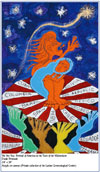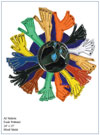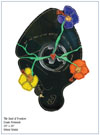
We Are You: A Portrait of America at the Turn of the Millennium, Penteado’s response to his friend’s query, is an insistent conflation of nationhood, birth, power, the present, and the future calling Latinos to recognize their position. “This painting is showing that the American flag is changing, with new sounds and colors,” he says. “The woman represents Mother America embracing many cultures, including people from Spain, South America, Puerto Rico, and more. This is the new baby—the Latino force, which is the fastest growing in America.”
In a broader stroke, Penteado insists the Latino community not miss the model of the Civil Rights Movement’s impact on America. “The Civil Rights Movement and Martin Luther King, Jr. were a form of inspiration all over the world, not only here. Whatever happens in the backyard of America reflects everywhere. Slavery and its effects went throughout the whole of South America, to the extent that in my hometown of São Paulo, an entire university has been developed to serve Afro-Brazilians,” who represented a meager two percent of Brazil’s 3,000,000 student college population according to the 2000 Census.
In an essay titled “Exhibiting Afro-Brazilian Art” in the 2003 Guggenheim release of the exhibit journal Brazil: Body and Soul, Emanoel Araújo, director of the Museo Afro-Brasil in São Paulo, aggressively pushed past cultural codes dictating strained social interactions in contemporary Brazil. “If Africans brought to Brazil as slaves soon underwent a process of becoming Brazilian, their masters and Brazilian society as a whole also underwent a process of Africanization due to contact with the slaves,” he wrote. Indeed, Africa’s imprint on Brazil dates back to the first century— when the North African Moors were to Portugal what the latter would be to Brazil’s pre-1500 indigenous population. Araújo’s assertions could easily ping against notions of Latin-ness in many sectors, where without confession little progress is possible.
“When you look at any revolution it starts with the artists and the intellectual community, which forms ideas,” says Faustino Quintinalla, director of the Queensborough Community College Art Gallery, which hosted an exhibit titled Relationships Between Patrons and Artists in African Culture in the early fall. “When you think about any people who are first persecuted it is the artists. The same way it has gone up it has to come down.” In detailing the effect art has on the us as individuals.
Quintanilla points to the practical nature of many works in the exhibit as culturally influential because “these are objects we use that have guided us to become what we are. That is why art is so important to life because eventually we change our lives—artists create, writers write and people read, and it affects their minds.”
When I look at the baby in the heart of the piece am I black, am I a Latino, or Jewish? The whole idea is to reflect, to provoke people to think about where we stand and ask what’s going on. What are the changes?
In the painting All Nations, Penteado exercises the idea that “ultimately, without dialogue and an understanding of where people come from they cannot find common ground.” In the case of nation states clinging to the notion of a purely Castilian heritage, their attitudes reject a well rich with legacy.
Conversely, Araújo’s treatment of Brazil’s race attitudes, which culminated in a 400-year retrospective exhibit at the Guggenheim, is striking. “[The exhibit] Negro de corpo e alma commemorated black people who worked in all artistic mediums and forms of representation and how they incorporated all of them while still bearing the stigmas created by a threatened hegemony,” he writes.
“No people has been treated with such great hostility on the basis of such banal and horrible preconceptions. No people has suffered so much rejection in the history of world civilizations. No people has ever been so objectified, hated and disdained, as if without soul and feelings. History has also shown that no other people has been so simultaneously a symbol of good and bad as blacks have been.”
The resilience Araújo celebrates has parlayed into an African world citizenry that is welcome in some corners and not in others. “The most documented influences are those of abstract African art on the Modernist Movement, as well as on Cubism and Surrealism in particular, and the international styles that grew out of them,” notes George Preston, professor of art at The City College of New York. Countries that strongly evince African influences— like Cuba, Brazil, and Haiti— continue to struggle with how such influences have permeated their cultures. Nonetheless, even in the contest there is value, for neither advocates nor detractors can stop the advent of cultural heralds prepared to confront traditions of denial and exclusion. Penteado’s cubist tendency to rearrange commonplace elements in his paintings functions as analogous support of identity as a fluid concept.
“I place mirrors in the center of my pieces and surround them with colors so you look and don’t know if you are Black, white, or Arab so you can engage in the process of finding your own identity,” says Penteado. “When I look at the baby in the heart of the piece am I Black, am I Latino, or am I Jewish? The whole idea is to reflect, to provoke people to think about where we stand and ask what’s going on. What are the changes?


